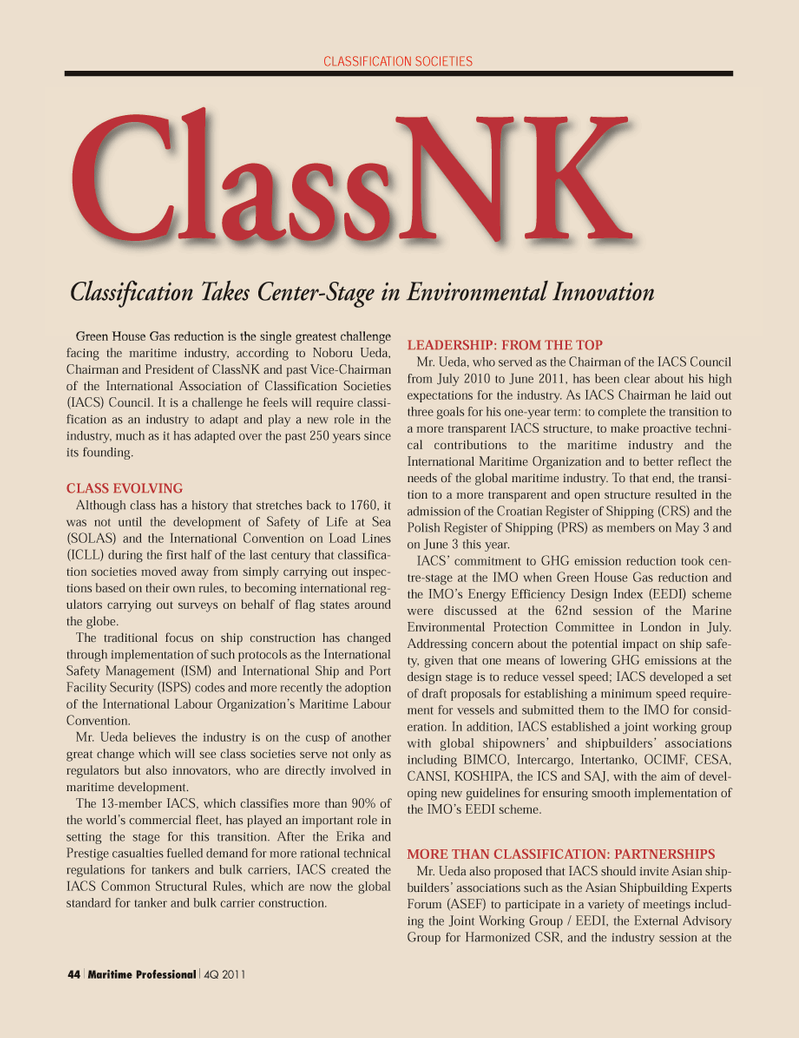
Page 44: of Maritime Logistics Professional Magazine (Q4 2011)
Classification
Read this page in Pdf, Flash or Html5 edition of Q4 2011 Maritime Logistics Professional Magazine
44 Maritime Professional 4Q 2011CLASSIFICATION SOCIETIES Green House Gas reduction is the single greatest challengefacing the maritime industry, according to Noboru Ueda, Chairman and President of ClassNK and past Vice-Chairman of the International Association of Classification Societies (IACS) Council. It is a challenge he feels will require classi- fication as an industry to adapt and play a new role in the industry, much as it has adapted over the past 250 years since its founding. CLASS EVOLVING Although class has a history that stretches back to 1760, itwas not until the development of Safety of Life at Sea (SOLAS) and the International Convention on Load Lines (ICLL) during the first half of the last century that classifica- tion societies moved away from simply carrying out inspec- tions based on their own rules, to becoming international reg- ulators carrying out surveys on behalf of flag states around the globe. The traditional focus on ship construction has changedthrough implementation of such protocols as the InternationalSafety Management (ISM) and International Ship and PortFacility Security (ISPS) codes and more recently the adoption of the International Labour Organization?s Maritime Labour Convention. Mr. Ueda believes the industry is on the cusp of another great change which will see class societies serve not only as regulators but also innovators, who are directly involved in maritime development. The 13-member IACS, which classifies more than 90% of the world?s commercial fleet, has played an important role in setting the stage for this transition. After the Erika and Prestige casualties fuelled demand for more rational technicalregulations for tankers and bulk carriers, IACS created the IACS Common Structural Rules, which are now the global standard for tanker and bulk carrier construction. LEADERSHIP: FROM THE TOP Mr. Ueda, who served as the Chairman of the IACS Council from July 2010 to June 2011, has been clear about his highexpectations for the industry. As IACS Chairman he laid out three goals for his one-year term: to complete the transition toa more transparent IACS structure, to make proactive techni- cal contributions to the maritime industry and the International Maritime Organization and to better reflect the needs of the global maritime industry. To that end, the transi- tion to a more transparent and open structure resulted in theadmission of the Croatian Register of Shipping (CRS) and the Polish Register of Shipping (PRS) as members on May 3 and on June 3 this year. IACS? commitment to GHG emission reduction took cen- tre-stage at the IMO when Green House Gas reduction andthe IMO?s Energy Efficiency Design Index (EEDI) scheme were discussed at the 62nd session of the MarineEnvironmental Protection Committee in London in July. Addressing concern about the potential impact on ship safe-ty, given that one means of lowering GHG emissions at the design stage is to reduce vessel speed; IACS developed a set of draft proposals for establishing a minimum speed require-ment for vessels and submitted them to the IMO for consid- eration. In addition, IACS established a joint working group with global shipowners? and shipbuilders? associations including BIMCO, Intercargo, Intertanko, OCIMF, CESA, CANSI, KOSHIPA, the ICS and SAJ, with the aim of devel- oping new guidelines for ensuring smooth implementation of the IMO?s EEDI scheme. MORE THAN CLASSIFICATION: PARTNERSHIPS Mr. Ueda also proposed that IACS should invite Asian ship- builders? associations such as the Asian Shipbuilding Experts Forum (ASEF) to participate in a variety of meetings includ- ing the Joint Working Group / EEDI, the External Advisory Group for Harmonized CSR, and the industry session at theClassNKClassification Takes Center-Stage in Environmental Innovation MP #4 (34-49):MP Layouts 11/8/2011 2:10 PM Page 44

 43
43

 45
45
